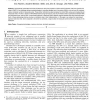Free Online Productivity Tools
i2Speak
i2Symbol
i2OCR
iTex2Img
iWeb2Print
iWeb2Shot
i2Type
iPdf2Split
iPdf2Merge
i2Bopomofo
i2Arabic
i2Style
i2Image
i2PDF
iLatex2Rtf
Sci2ools
TC
2008
2008
Analysis of Mask-Based Nanowire Decoders
Stochastically assembled nanoscale architectures have the potential to achieve device densities 100 times greater than today's CMOS. A key challenge facing nanotechnologies is controlling parallel sets of nanowires (NWs), such as those in crossbars, using a moderate number of mesoscale wires. Three similar methods have been proposed to control NWs using a set of perpendicular mesoscale wires. The first is based on NW differentiation during manufacture, the second makes random connections between NWs and mesoscale wires, and the third, a mask-based approach, interposes high-K dielectric regions between NWs and mesoscale wires. Each of these addressing schemes involves a stochastic step in their implementation. In this paper, we analyze the mask-based approach and show that, when compared to the other two schemes, a large number of mesoscale control wires are necessary for its realization.
Densities 100 Times | Information Technology | Mesoscale Wires | Perpendicular Mesoscale Wires | TC 2008 |
| Added | 15 Dec 2010 |
| Updated | 15 Dec 2010 |
| Type | Journal |
| Year | 2008 |
| Where | TC |
| Authors | Eric Rachlin, John E. Savage |
Comments (0)

